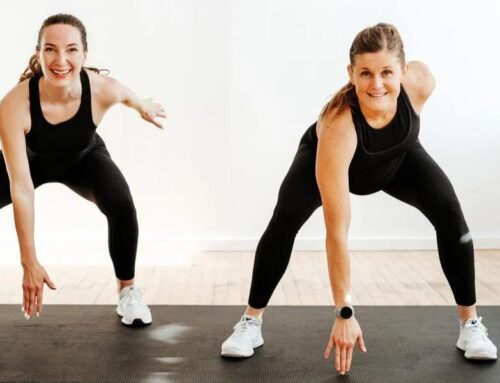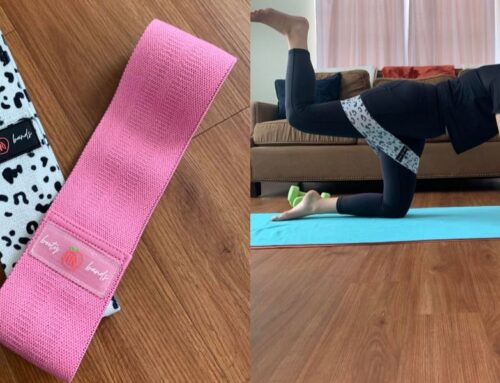
Are you tired of dealing with stubborn saddlebags, those pockets of fat that tend to accumulate on the outer thighs?
Saddlebags can be a source of insecurity for many individuals, especially during the warmer months when clothing options are more revealing. However, with the right strategies, it is possible to reduce the appearance of saddlebags and feel more confident in your own skin.
In this article, we’ll explore 7 effective tips to help you get rid of saddlebags once and for all. From targeted exercises to healthy eating habits, these tips can help you tone and tighten your lower body, while also reducing overall body fat.
So, let’s get started!
What are saddlebags?
Saddlebags are pockets of fat that tend to accumulate on the outer thighs, giving the appearance of a bulge or bump. These fat deposits are often stubborn and difficult to eliminate, even with diet and exercise. Saddlebags can affect both men and women but are more commonly seen in women due to the way that the female body stores fat.
Saddlebags are named after the bags that are hung on the sides of a horse’s saddle. They typically occur in the area below the hips and above the knees, and can vary in size and shape depending on the individual. Saddlebags can be a source of insecurity for many individuals, especially during the warmer months when clothing options are more revealing.
Fortunately, there are ways to reduce the appearance of saddlebags through a combination of healthy eating habits, regular exercise, and targeted strength training exercises. By focusing on these strategies, individuals can work towards toning and tightening the muscles in the outer thighs, while also reducing overall body fat.
What causes saddlebags?
Saddlebags refer to the excess fat deposits that tend to accumulate on the outer thighs, giving the appearance of a bulge or pocket. These stubborn fat deposits can be frustrating for many individuals, especially since they can be difficult to eliminate even with diet and exercise.
There are several factors that contribute to the development of saddlebags, including:
- Genetics: Saddlebags can be hereditary, meaning that if your parents or other family members have them, you may be more likely to develop them as well.
- Hormones: Hormones also play a role in the development of saddlebags. For example, women tend to accumulate more fat in their hips and thighs due to the hormone estrogen. Changes in hormone levels during puberty, pregnancy, and menopause can also affect fat distribution.
- Age: As we age, our metabolism slows down and we tend to lose muscle mass, which can lead to a decrease in calorie burn and an increase in fat accumulation.
- Sedentary lifestyle: A lack of physical activity can contribute to the development of saddlebags, as the muscles in the hips and thighs become weaker and less toned.
- Poor diet: A diet high in processed foods, sugar, and unhealthy fats can lead to weight gain and fat accumulation in the saddlebag area.
Overall, the development of saddlebags is a complex interplay of genetics, hormones, age, lifestyle factors, and diet. To reduce saddlebags, it’s important to focus on a healthy, balanced diet, and engage in regular physical activity that targets the muscles in the hips and thighs. Incorporating strength training exercises like lunges, squats, and leg lifts can help to tone and tighten the muscles in the lower body, while cardio exercises like running, cycling, or swimming can help to burn calories and reduce overall body fat.

How to Get Rid Of Saddlebags
Saddle bags are one of the most common cosmetic concerns among women. These pesky pockets of fat can be very difficult to get rid of, but there are some things you can do to help get rid of them for good.
1. Exercise regularly.
Regular exercise is a crucial component of reducing the appearance of saddlebags. Cardio and strength training exercises can help to burn calories, increase muscle mass, and improve overall fitness levels, all of which can contribute to a reduction in body fat and the appearance of saddlebags.
When it comes to targeting the outer thighs, it’s important to incorporate exercises that engage the muscles in this area. Some effective exercises for reducing saddlebags include:
- Side-lying leg lifts: Lie on your side with your bottom leg bent and your top leg straight. Lift your top leg as high as you can, then lower it back down. Aim for 10-15 repetitions on each side.
- Lateral lunges: Stand with your feet hip-width apart, then step your left foot out to the side and lower into a lunge position. Push back up to standing, then repeat on the other side. Aim for 10-15 repetitions on each side.
- Sumo squats: Stand with your feet wider than hip-width apart, toes turned out at a 45-degree angle. Lower down into a squat position, then push back up to standing. Aim for 10-15 repetitions.
Incorporating cardio exercises like running, cycling, or swimming can also help to burn calories and reduce overall body fat. Aim for at least 150 minutes of moderate-intensity cardio per week, or 75 minutes of high-intensity cardio per week.
Remember, consistency is key when it comes to exercise. Aim to incorporate regular exercise into your routine, ideally 3-5 times per week, and gradually increase the duration and intensity of your workouts as you get stronger. By doing so, you can work towards reducing the appearance of saddlebags and achieving a more toned and trim the lower body.
2. Eat a healthy diet.
Eating a diet that is rich in whole, nutrient-dense foods can help to support overall health and well-being, while also promoting a healthy body weight and reducing the appearance of saddlebags.
Aim to consume a variety of fruits, vegetables, whole grains, lean proteins, and healthy fats, while limiting processed and high-sugar foods. This can help to support healthy digestion, reduce inflammation in the body, and provide your body with the energy and nutrients it needs to function optimally.
3. Drink plenty of water.
Staying hydrated is important for overall health and can also help to reduce the appearance of saddlebags. Aim to drink at least 8-10 glasses of water per day, and more if you’re active or live in a hot climate. Drinking water can help to flush toxins out of the body, improve skin health, and promote healthy digestion, all of which can contribute to a reduction in the appearance of saddlebags.
4. Avoid crash diets.
While crash diets may promise quick weight loss results, they can actually be harmful to your overall health and may even contribute to the appearance of saddlebags.
Crash diets typically involve severely restricting calories or eliminating entire food groups, which can lead to nutrient deficiencies, metabolic imbalances, and muscle loss. As a result, your body may actually hold onto fat stores in an effort to conserve energy, making it more difficult to reduce the appearance of saddlebags. Instead of crash dieting, focus on making sustainable changes to your diet and lifestyle that you can maintain over the long term.
5. Don’t smoke.
Smoking not only increases the risk of several chronic diseases, but it can also contribute to the appearance of saddlebags. Smoking can reduce circulation to the lower body, leading to the accumulation of fat stores in the outer thighs. Additionally, smoking can damage the collagen and elastin fibers in the skin, making it more difficult to maintain a healthy, firm skin tone. If you currently smoke, quitting can help to improve your overall health and reduce the appearance of saddlebags over time.
6. Get enough sleep.
Getting enough restful sleep is essential for overall health and well-being, and can also help to reduce the appearance of saddlebags. Lack of sleep can disrupt hormone levels, increase inflammation in the body, and lead to overeating and weight gain, all of which can contribute to the appearance of saddlebags. Aim to get 7-9 hours of sleep each night, and establish a regular sleep routine to help promote better sleep quality.
7. Reduce stress.
Chronic stress can also contribute to the appearance of saddlebags, as it can lead to overeating, hormonal imbalances, and inflammation in the body.
Engaging in stress-reducing activities, such as yoga, meditation, or deep breathing exercises, can help to reduce stress levels and promote overall well-being. Additionally, engaging in regular physical activity can help to reduce stress levels and promote a more positive outlook.
SaddleBags FAQs.
Can you get rid of saddlebags with diet and exercise?
Yes, you can get rid of saddlebags through diet and exercise. However, it will take some time and effort to achieve the desired results. For best results, combine a healthy diet with regular cardiovascular and strength-training exercises.
What are some effective exercises for getting rid of saddlebags?
There are many effective exercises for getting rid of saddlebags. Cardiovascular exercises such as walking, jogging, and biking can help burn the fat that contributes to saddlebags. Strength-training exercises such as squats and lunges can help tone the muscles in the area, making them appear more defined.
How long does it take to get rid of saddlebags?
The amount of time it takes to get rid of saddlebags depends on a number of factors, including your starting weight, your diet, and your exercise routine. Generally speaking, it will take several weeks or even months of dedication to see significant results.
Can you get rid of saddlebags with surgery?
Yes, you can get rid of saddlebags with surgery. However, this should be considered a last resort as it is an invasive and expensive procedure. If you are considering surgery, speak to a qualified plastic surgeon to discuss your options.
Conclusion
Saddlebags, or the excess fat that accumulates on the outer thighs and hips, can be frustrating and difficult to get rid of. However, with a combination of targeted exercises, healthy eating habits, and lifestyle changes, it is possible to tone and slim your hips and thighs.
In this article, we have explored 7 effective tips to get rid of saddlebags once and for all. We’ve discussed the importance of a balanced diet that is low in processed foods and high in protein, fiber, and healthy fats. We’ve also explored the benefits of cardiovascular exercise, which helps to burn calories and reduce overall body fat.
In addition to cardio, we’ve highlighted several exercises that target the outer thighs and hips, such as squats, lunges, and leg lifts. We’ve also discussed the benefits of strength training, which can help to build lean muscle mass and boost metabolism.
Lifestyle changes such as reducing stress, getting enough sleep, and staying hydrated can also play a significant role in slimming down saddlebags. We’ve discussed the benefits of incorporating relaxation techniques such as yoga and meditation, as well as the importance of staying hydrated and getting enough sleep.
By incorporating these tips into your daily routine, you can begin to see real results in your efforts to get rid of saddlebags. Remember to be patient and consistent, as it may take time to see the full effects of your hard work. With dedication, persistence, and a positive attitude, you can achieve the toned, slim legs and hips that you’ve always wanted.



